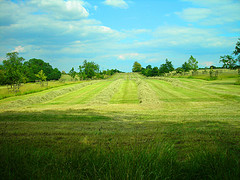Don’t Bag Those Grass Clippings – Use Them!
 Like it or not, cutting the grass is a chore that needs to be done on a regular basis by anyone who has a lawn. But once you’re finished mowing, what do you do with all the grass clippings left behind? Bagging and binning them is wasteful, since it just adds to our country’s landfills (and has been prohibited in certain states -- Georgia, for example). Here are some alternative ideas for what to do with the by-product of your Atlanta yard maintenance. NOTE: All these uses are suggested only for clippings from grass which has not been recently treated with either pesticides or herbicides.
Like it or not, cutting the grass is a chore that needs to be done on a regular basis by anyone who has a lawn. But once you’re finished mowing, what do you do with all the grass clippings left behind? Bagging and binning them is wasteful, since it just adds to our country’s landfills (and has been prohibited in certain states -- Georgia, for example). Here are some alternative ideas for what to do with the by-product of your Atlanta yard maintenance. NOTE: All these uses are suggested only for clippings from grass which has not been recently treated with either pesticides or herbicides.
Animal Fodder
Grass clippings are an excellent source of nutrition for farm animals such as sheep or cows, as well as herbivorous (plant-eating) household pets like rabbits and guinea pigs. They have the added advantage of being available for free, saving money on fodder. Any grass to be used for animal food should be cut by an exhaust-free mower, for instance a cordless electric or a manual model. Keep the clippings dry and do not allow them to ferment before feeding your livestock, since this may cause digestive disturbances.
Compost
Green grass will enrich your compost heap with nitrogen, phosphorous and potassium. Clippings act as green matter when composted fresh and brown matter after they have been thoroughly dried. The recommended ratio for successful composting is 1 part green matter to 2 parts brown. If the clippings are too much for you to compost yourself, you can opt to send them to your regional composting facility instead.
Lasagna Garden Layer
Use grass clippings as one of the layers of organic material in a multi-tiered lasagna garden, an innovative method of raised bed gardening as described by author Patricia Lanza. This type of easy care gardening reportedly requires no digging, tilling or weeding.
Mulch
Reduce the amount of watering required by trees, bushes and other plants in your yard and garden. Spread a thin covering of dried grass clippings onto the earth around the plants. As the grass decomposes, it can be mixed into the soil to provide a source of enrichment. Although dedicated mulching mowers or mulching attachments for regular mowers are available, they are not really necessary. Just set your mower on high and make sure that the blades are sharp. Grass clippings may also be used to mulch the lawn itself; all you need to do is detach your mower’s collection bag and allow the clippings to remain where they fall.
Weed Control
Besides reducing your water bills, recycling grass clippings as mulch serves as a “green” form of weed control. Because the mulch covers the soil, it acts to block any weed seeds underneath from accessing the sun rays they need in order to germinate. This means that you do not need to use environmentally dangerous herbicides. (Before spreading the clippings, you are advised to pull out by the roots any weed plants which have already sprouted.) To make this method even more effective, place a thin layer of newspaper over the soil and then distribute the clippings on top.
Environmentally Friendly Fire Logs
The U.S. Department of Agriculture has begun researching an inventive new means of utilizing grass clippings. Mixed with plant-based binders such as waxes, the clippings are used to create artificial fire logs, sticks and pellets which are eco-friendly, containing no petroleum derivatives. These logs can be enhanced with organic oils to produce attractive colors and scents when burned and … better yet! … to keep insect pests away from your campfire.
Laura Firszt writes for Networx.com.
Looking for a Pro? Call us (866) 441-6648

Landscaping Average Costs
Landscapers Experiences

Oak Tree Planting Looks Great In Our New Home’s Spacious Yard

Find A Reliable Full Service Crew For No-Fuss Tree Removal



